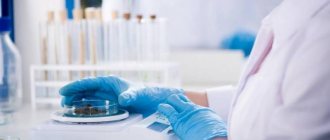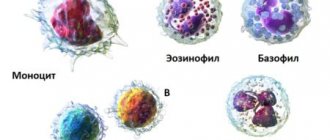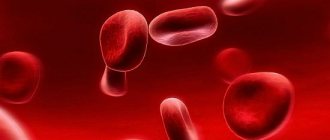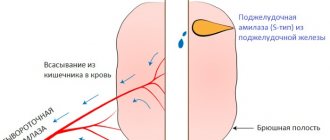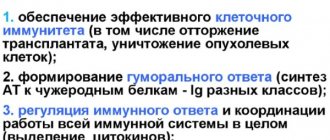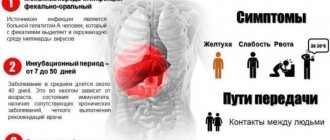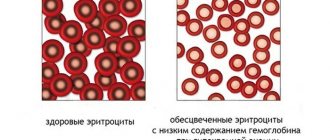On average, the surface area of the adult human intestine is about 200 m², which is home to about 500 species of different bacteria. All of them are necessary for digestion, synthesis of vitamins, formation of immunity, stabilization of metabolism and protection against pathogenic microorganisms. Violation of the qualitative and quantitative composition of the intestinal flora leads to serious problems. Dysbacteriosis requires careful diagnosis and passing the necessary tests.
- 1.1 Clinical signs of intestinal dysbiosis in adults
- 1.2 What symptoms of the disease may occur in infants?
- 1.3 Can a doctor diagnose dysbiosis in a newborn?
1.3.1 What causes the proliferation of streptococci and staphylococci, Klebsiella, clostridia, fungi
- 2 Diagnostics: coprological, biochemical, biological research
- 3 How to submit feces for analysis: preparation for the study
3.1 Testing stool for dysbacteriosis - video
- 5.1 Constantly present bacteria: norms - table
5.2.1 Explanation of results - table
What condition can be called dysbiosis?
Dysbacteriosis, or dysbiosis, is a syndrome characterized by a change in the quality and/or quantity of the intestinal bacterial flora towards excessive growth of opportunistic microorganisms. The term “dysbacteriosis” was introduced in 1916 by the German doctor A. Nissle.
Intestinal microflora is a collection of various microorganisms
The qualitative composition of the intestinal microflora is a relatively constant value, which is associated with the action of the following factors:
- the amount of wall mucus containing bacteria;
- synthesis of local immunoglobulins;
- integrity of the intestinal mucosa;
- destruction of pathogenic microorganisms using gastric juice, which ultimately do not enter the small intestine.
Despite a certain constancy, the bacterial composition varies depending on the season, age and nutrition.
Manifestations of dysbacteriosis can vary in severity (depending on the degree of development of the pathology). Tank. Stool culture will help determine the degree of pathology:
- The first degree is characterized by a hidden course of dysbiosis and is revealed only during a scatological examination.
- The second degree - the starting phase, is manifested by a clear deficiency of bifidobacteria and lactobacilli, as well as the growth of pathogenic flora.
- The third degree is expressed in the aggressive behavior of pathogenic bacteria.
- The fourth degree is characterized by the absence of “good” E. coli and a sharp decrease in bifidobacteria and lactobacilli. Pathogenic Escherichia, Salmonella, Shigella, and Clostridia multiply.
Clinical signs of intestinal dysbiosis in adults
Clinical picture of dysbiosis in adults:
- disorders in the digestive tract: dyspeptic symptoms, for example, nausea, vomiting, poor appetite;
- signs of fermentation in the intestines: foul-smelling belching, flatulence, rumbling;
- pain syndrome of varying severity, often characterized by spasm;
- violation of intestinal evacuation: constipation, diarrhea and their alternation, a feeling of incomplete emptying, feces with mucus, with a sour or putrid odor;
Abdominal pain may be a sign of dysbiosis
What symptoms of the disease may occur in an infant?
Symptoms of dysbacteriosis in infants:
- bloating, unpleasant smell of gas from the intestines;
- pain in the intestines, intensifying after feeding (the child presses his legs to his stomach);
- frequent and profuse regurgitation, vomiting;
- diarrhea for more than 2 days, constipation;
- impurities in feces: mucus, foam, streaks of blood;
The disease in the baby may manifest itself as regular night crying.
- dry skin;
- poor weight gain;
- restless sleep;
- regular night crying.
It should be understood that each of the listed symptoms may be a sign of another pathology not related to dysbiosis, so it is very important to consult a specialist for examination and adequate examination.
Can a doctor diagnose dysbiosis in a newborn?
Recently, the issue of dysbiosis in newborns (babies from birth to 28 days of life) has become increasingly controversial.
Some experts believe that it is wrong to talk about dysbiosis in newborns, since a child is born with a sterile intestine, which becomes filled with bacteria as the baby grows and develops. This process ends by 3–5 months, depending on gender. The formation of your own intestinal flora can bring discomfort and cause unpleasant symptoms.
After conducting numerous studies, it was suggested that colonization of the intestine begins in fetal development. That is, a child is born with elementary microflora, thanks to which there is initial immunity. Bifidobacteria are the main type of microorganisms in the intestines of a newborn baby, so “guests” become the culprits of adverse symptoms.
What does the proliferation of streptococci and staphylococci, Klebsiella, clostridia, and fungi lead to?
Bifidobacteria and lactobacilli are already present in the intestines of an infant at 4 months, the deficiency of which frees up space for the proliferation of pathogenic representatives of the microflora:
- An increase in the number of streptococci and staphylococci (including aureus) leads to hypersensitivity of the body, that is, it provokes allergic reactions and infectious processes, for example, sore throats, skin infections, and urinary tract infections.
- Klebsiella causes lactase deficiency.
- Clostridia contribute to the occurrence of diarrhea.
- The proliferation of Candida fungi leads to the development of candidiasis.
Doctor Komarovsky about dysbiosis - video
How to eliminate intestinal dysbiosis?
Dysbiosis cannot occur by chance; it always signals a disease that has become the cause that led to disturbances in the bacterial background. If you ignore the root cause, the situation will not be completely normalized.
When a disease is detected and treated, attention must be paid to a special diet. Specific recommendations are related to the person’s condition, age and other characteristics. General advice boils down to forming a diet of fermented milk products, cereals, root vegetables, and mushrooms.
Diagnostics: scatological, biochemical, biological research
A doctor should make a conclusion about the presence or absence of dysbacteriosis only after conducting laboratory tests and excluding more serious pathologies.
A number of stool studies are recommended:
- scatological;
- biochemical;
- biological.
The result of a stool test can be obtained in 8–10 days.
In addition, the mucous membrane is washed off during gastroduodenoscopy and colonoscopy. Using endoscopic methods, intestinal flora can be reliably assessed.
Analysis of stool for dysbacteriosis is not a standard test. The bacteria located in the intestinal lumen and near the wall are not identical. That is, microbes that need to be gotten rid of “come out” with the feces, but the flora necessary for the intestines remains.
However, when carrying out scatological and biochemical analysis, it is possible to indirectly assess the situation in favor of one or another pathological microorganism, for example, with an increase in the amount of Klebsiella in the feces, mucus is detected, and its pH becomes acidic.
How to take stool for analysis: preparation for the study
To reliably detect the presence or absence of signs of disease, it is necessary to correctly submit the biomaterial.
Basic conditions:
- biomaterial is obtained without taking laxatives or enemas;
- the sample must be fresh, the morning portion is ideal;
- Before collecting the material, it is recommended to follow a diet with a reduced amount of foods that cause fermentation and rotting in the intestines;
- women during menstruation must wait until it ends;
- It is prohibited to take medications that affect the functioning of the digestive system (for example, activated carbon, Maalox);
Before taking a stool sample, you need to urinate, carry out hygiene measures, and then take a sample equal to a teaspoon in volume, place it in a special container and seal it tightly.
Testing stool for dysbacteriosis - video
Preparation and rules for collecting material
The preparatory period begins three days before the delivery of feces. It is necessary to stop taking any laxatives, giving rectal suppositories and enemas. You should also not take any antibiotics or anti-inflammatory drugs.
A sterile container is taken in advance at the clinic or purchased at the pharmacy. Feces are collected with a wooden or plastic spatula, no more than 10 grams. Before defecation, you need to wash yourself with water, but do not use any soap. For women, it is better to place a pad on the perineum so that secretions or drops of blood do not get into the material for analysis. Men just need to be careful not to get any urine.
You need to bring stool to the laboratory for analysis on the same day, no later than three hours later. It is not recommended to store the material, as the results may be distorted.
What can the analysis result show?
All intestinal bacteria are usually divided into three groups:
- Obligate (constantly present) - bifidobacteria and lactobacilli, Escherichia coli, Veillonella, Peptococcus, Bacteroides. Promote the formation of a film that protects the intestinal mucosa and acidify the environment to pH 4–5.
- Additional or accompanying - staphylococci, fungi.
- Transient bacteria, or random flora - Klebsiella, Clostridia, Streptococcus, Proteus, that is, opportunistic flora.
Accessory and transient bacteria should make up no more than 4% of the total mass of intestinal microorganisms, of which opportunistic bacteria should be less than 105 μ/g.
For clarity, you can imagine that 1 gram of feces contains 1 billion bifidobacteria, 1 million E. coli, and up to 10 thousand pathogenic microorganisms. This is the physiological ratio of the bacterial environment in the intestine.
Constantly present bacteria: norms - table
| Microorganisms | Normal quantity |
| Bacteroides | 10 5–12 mcg |
| Lactobacilli | 10 5–7 mcg |
| Bifidobacteria | 10 8–10 mcg |
| Escherichia coli | 10 6–9 mcg |
| Enterococcus | 10 3–9 mcg |
Key indicators to pay attention to: mucus, blood, starch
After a year, the child’s intestinal microflora becomes almost the same as that of an adult.
The qualitative and quantitative composition of feces does not depend on the gender of the person.
Particular attention should be paid to the following indicators:
- Slime. With its help, the intestines are cleansed of pathological inclusions. The presence of mucus in the stool of an adult is a sign of intestinal infection, polyps, intolerance to dairy products, diverticulosis and other pathologies. In infants who feed exclusively on mother's milk, this indicator may appear when new foods are added to the diet. If an admixture of mucus is observed for several days and the child’s behavior has changed, an examination by a pediatrician and related specialists is necessary.
- Blood. Regardless of age, the indicator must be negative. There are many diseases that cause blood in the stool: hemorrhoids, anal fissures, ulcers of various locations, polyps, inflammatory and infectious intestinal pathologies.
- Stercobilin. Thanks to it, feces acquire a dark color. An increase in stercobilin means an increase in the volume of bile or increased secretion, as well as the development of hemolytic anemia. A decrease in pigment levels is most often a sign of liver or biliary tract disease: hepatitis, cholelithiasis (GSD) and bile duct stones, cholangitis.
- Bilirubin. In the intestine, under the influence of bacteria, it is converted into stercobilin. An increase in the indicator indicates the immaturity of the intestinal bioflora, for example, in infants, or a decrease in the number of necessary microorganisms, for example, in adults with dysbacteriosis, accelerating the evacuation of intestinal contents.
- Muscle and connective tissue fibers. They provide an indirect assessment of the functional capacity of the digestive system, that is, how well protein foods are digested. Muscle fibers may be slightly present, while connective tissue fibers should not be prominent. An increase in the number of undigested muscle fibers and the presence of connective tissue indicates chronic gastritis, dyspepsia, pancreatitis and increased intestinal motility.
- Starch. The detection of starch in a stool test indicates poor digestion of sugars. In this case, we can assume the presence of chronic diseases of the digestive glands, increased intestinal motility, in which nutrients transit through the digestive tube.
- Fatty acid. A product of the breakdown of neutral fats. Their presence indicates problems in the biliary system, liver, and pancreas.
- Leukocytes. They are an indicator of inflammatory changes in the intestines of an adult. In young children they are normally present in small quantities.
Decoding the results - table
| Indicators | Breast-feeding | Artificial feeding | Older children and adults |
| Consistency | liquid, mushy | mushy, putty-like | decorated |
| Color | yellow | brown | brown |
| Smell | sourish | putrefactive | fecal |
| Acidity | 4,8–5,8 | 6,8–7,5 | 7–7,5 |
| Slime | may be present | — | — |
| Blood | — | — | — |
| Soluble protein | — | — | — |
| Stercobilin | + | + | 75–350 mg/day |
| Bilirubin | + | + | — |
| Ammonia | — | — | — |
| Detritus | different meaning | different meaning | different meaning |
| Muscle fibers | small quantity or absent | a small amount of | — |
| Connective tissue fibers | — | — | — |
| Starch | — | — | — |
| Plant fiber | — | — | — |
| Fatty acid | in small quantities | in small quantities | — |
| Leukocytes | single | single | single |
Is it worth doing a stool test?
To this day, the question of the reliability of scatological analysis for diagnosing dysbiosis and prescribing treatment remains open. But if a full examination of stool is done, that is, a microbiological and chemical analysis is also carried out, we can speak with certainty about a violation of the breakdown and absorption of certain substances. In this case, the conclusion with the result in the hands of a specialist becomes a reliable clue in the diagnosis of many diseases of the digestive tract and more.
To normalize the microbiological composition of the intestinal flora, three groups of drugs are used:
- prebiotics - substances that promote the proliferation of “good” bacteria;
- probiotics - preparations with live microorganisms;
- Eubiotics are biosynthetic agents that improve the conditions for the existence of bacteria in the intestine.
Reasons for the development of dysbiosis
Dysbiosis occurs in connection with gastrointestinal diseases.
Dysbiosis is a phenomenon characteristic of various systems of the human body, where certain bacteria must be located. This concept is applied to the genitourinary system and respiratory organs. Dysbiosis develops in a variety of cases. The main reasons that provoke an imbalance in the internal flora of a person are the following:
- diseases of the gastrointestinal tract;
- taking serious medications;
- stress;
- unsatisfactory state of the environment.
Often there is more than one reason, several problems appear in combination. To begin correcting the condition, it is necessary to accurately identify the cause of the violations. After all, treatment comes down to eliminating the causes that led to the disorders.

